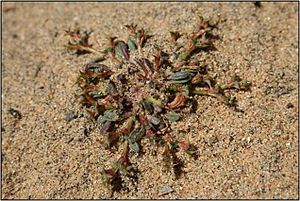Orcutt's spineflower facts for kids
Quick facts for kids Orcutt's spineflower |
|
|---|---|
 |
|
| Conservation status | |
| Scientific classification | |
| Genus: |
Chorizanthe
|
| Species: |
orcuttiana
|
The San Diego spineflower (Chorizanthe orcuttiana) is a very rare and tiny plant. It is an annual plant, meaning it lives for only one year. This special plant belongs to the buckwheat family. It is found only in San Diego County, California, making it an endemic species.
Contents
What Does the San Diego Spineflower Look Like?
This plant is so small that you often need a magnifying glass to see it properly! It is very sensitive to the weather. If it's too hot or there isn't enough rain, its seeds might not sprout or survive.
You can usually spot the plant from February to July in years with good rainfall. But in most years, it's only visible from April to June. Each tiny flower on the plant produces just one seed. Scientists believe this plant is a mix of other Chorizanthe species, perhaps C. procumbens and C. polygonoides.
Where Does This Plant Live?
The San Diego spineflower needs open spaces near the coast to grow. It likes places like sandstone cliffs and clearings in coastal chaparral areas. Chaparral is a type of shrubland found in California.
Sadly, a lot of this coastal chaparral habitat in San Diego County has been lost. People have built homes and businesses, and human activities like recreation have damaged these areas. Most of the known San Diego spineflower plants are found within five kilometers (about three miles) of the coastline. They grow in white sandy soils that are not too acidic and don't have much organic material. These soils come from iron-rich sandstone.
Where Can We Find It Today?
For a while, people thought the San Diego spineflower was gone forever. But then it was found again on Point Loma. Since then, two more groups of these plants were discovered on Naval Base Point Loma. A very small group is sometimes seen at Oak Crest Park in Encinitas, California. Lately, this group has sometimes been just one single plant!
Most of the places where this plant used to grow have been developed. However, because the plant is so tiny and hard to find, there's a chance that other groups of them exist that haven't been discovered yet. They might even be in places like Torrey Pines State Park, where they have been seen before. The most recent guess is that there are only about 470 to 3,000 San Diego spineflower plants left in the entire world. Because it is so rare, the United States government has listed it as an endangered species.
Why Is the San Diego Spineflower Endangered?
The biggest danger to the San Diego spineflower comes from non-native plants. These are plants that were brought to the area from other places and now grow out of control. Examples include ice plant and Natal grass. These non-native plants can take over the space and resources that the spineflower needs to survive.
The San Diego spineflower is also threatened because there are so few groups of plants left, and each group is very small. This makes it more likely for the species to disappear completely. While the plant might naturally be rare, its situation is made worse by other issues, such as efforts to stop natural fires. Fires can sometimes help clear out competing plants, creating the open spaces the spineflower needs.


